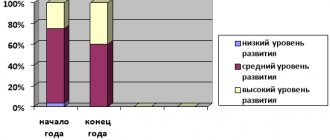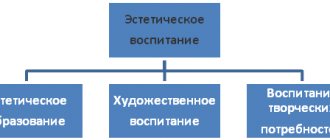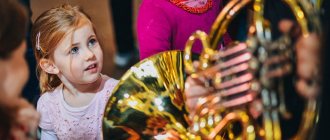Aesthetic education (EA) is an integral part of the formation, development and formation of personality. From the first years of life, a child begins to study art, beauty, virtue, the diversity of the surrounding world, society, therefore, it is at this age that a teacher must be able to competently organize the process of learning about the artistic sphere.
Clear objectives are set for each age group. The training program is developed on the basis of scientific data, focusing on a variety of art forms, taking into account modification and progression of each of them. New skills are taught in stages, with gradually increasing demands on students' knowledge.
The earlier the aesthetic effect is reproduced, the greater the chances of its effectiveness. The formation of an artistic culture of personality in preschoolers is effectively carried out during play activities. Children begin to actively imitate the standards of cultural communication, as well as behavior in society, and their perception and acceptance of the world around them consistently develops.
Apart from this, they have a great desire to observe and create art/beauty, which is otherwise called creative energy. Thanks to this phenomenon, special attention is paid to the problem of updating aesthetic education. After all, only culturally enriched and purposeful people are able to make a contribution to the development of world art.
The cultural integrity of the individual becomes the main factor for awakening the desire to transform, decorate, modernize the natural and objective environment, nature, society, since closeness to life is a paramount circumstance for a harmonious life.
Goals of aesthetic education
The main goal is the formation of an individual’s aesthetic culture. An aesthetically educated child develops virtuous, moral, and spiritual values; His knowledge about nature, society, and the essence of the world expands.
Various artistic activities develop character traits such as attentiveness, perseverance, and discipline. Therefore, the goals of EV should also include:
- the formation of a holistic personality capable of openly expressing one’s thoughts, speaking out, expressing oneself, sympathizing and empathizing in various life situations;
- the development of a highly moral, harmonized, multifaceted person, distinguished by his uniqueness from other individuals.
Domestic and foreign systems of music education
During the period of artistic education, the following aesthetic components are formed, necessary for the generality and quality of the process:
- Perception is the ability to identify aesthetic features in everyday, cultural and social life. Subsequently, what is perceived is assessed by the individual according to personal criteria formed as a result of receiving emotional and intellectual experience.
- Feelings are the manifestation of emotions that arise as a result of interaction with another person, art, environment or society. Such feelings can cause pleasure, joy, inspiration, sadness or disgust. They are associated with more complex intellectual and emotional processes, and are also distinguished by their depth, variety, and complexity. But despite this, such persistent emotions are always in harmony with the mind.
- Interest is a person’s desire for new knowledge. The main criterion of aesthetic interest is whether an individual has favorite works of art, writers, composers; books that he often rereads; the presence of purposefulness in choosing the genre of music and literature.
Means ↑
The means of introducing beauty are:
- fine arts (painting, sculpture);
- dramaturgy (theater);
- architecture;
- literature;
- television, media;
- music of various genres;
- nature.
Methods include:
- personal example;
- conversations;
- school lessons and classes in kindergarten, clubs, studios;
- excursions;
- visiting the theater, exhibitions, museums, festivals;
- matinees and evenings at school and preschool educational institutions.
The most effective of all methods is the personal example of a teacher (parent). Through it, the ideal is formed, which then forms the basis of all artistic consciousness. Personal example includes: behavior, communication, appearance and moral qualities.
Objectives of aesthetic education
The implementation of the previously listed goals is not possible without a clear formulation and implementation of a number of pedagogical tasks. They, in turn, are divided into two categories:
The first group is aimed at developing an aesthetic attitude in children. In this case, the following tasks must be performed:
- formation of the sensory side of personality;
- developing the ability to see beauty and uniqueness in people, objects, nature, art, society;
- acquaintance with the basic standards, individual cultural qualities and manifestations of personality, as well as the gradual introduction of new terminology into the student’s colloquial vocabulary;
- understanding the essence of beauty;
- education in students of unique features, ideas, reasoning, concepts that play an explanatory role in understanding all aesthetic components;
- emotional development – the ability to give an adequate reaction (joy, laughter, disappointment, agreement, etc.) in any situation.
Forms and methods of aesthetic education
The second group - pedagogical tasks are to encourage children to perform artistic and aesthetic activities, to develop and acquire certain skills and abilities. Various methods are used to introduce schoolchildren and preschoolers to art/culture (for example, drawing, modeling, singing, dancing, reading poetry). In addition, a desire is formed to bring and apply the acquired skills in real life.
Goals and objectives
The goal of aesthetic education is simple and complex at the same time: to teach a person to see beauty in all its manifestations, analyze and evaluate what he sees, and take an active part in its creation.
The tasks of raising an aesthetically developed personality are also multifaceted. They are conditionally divided into 2 groups.
Group 1 of tasks works in the following direction:
- Forms taste and a creative attitude towards the surrounding nature;
- Develops the ability to feel, hear, see beauty in nature, art, literature, and people’s actions;
- Fosters the need to contemplate beauty and excellent artistic taste.
Group 2 of tasks is aimed at developing the skills to create beauty in art and everyday life.
Only the close interaction of these tasks will allow achieving high educational results.
Contents of aesthetic education
The content of electronic learning includes the formation of skills, tastes, needs, interests, standards and assessments. As a result of a joint form of artistic activity, children gain new knowledge that helps them understand the essence and diversity of the world around them.
They learn to distinguish between good and bad, ugly and beautiful, good and evil, comic and tragic. Against the background of the acquired information, the concept of aesthetic culture comes as the most multifaceted, sublime area.
Preschoolers get acquainted with art from the first years of life, through arts and crafts architecture, sculpture, painting, and folk art. In kindergarten, children begin to actively engage in independent artistic activities - they draw, sculpt from plasticine, cut out crafts, sing, dance.
The teacher must provide the necessary conditions for comfortable and effective completion of tasks, provide support, and give students the right direction. A correct program, which includes a variety of forms of EV, guarantees the fulfillment of all functions and the comprehensive aesthetic development of the personality of a child of preschool and school age.
Under the clear guidance of a teacher or adult, children must understand the main criteria that serve as an assessment in the distinction between bad/good, sublime/ordinary, beautiful/ugly, in order to then apply the experience gained in later life.
Consultation “The importance of artistic and aesthetic education in the development of preschool children”
Anastasia Gerasimova
Consultation “The importance of artistic and aesthetic education in the development of preschool children”
Artistic and aesthetic education is a purposeful process of forming a creative personality capable of perceiving , feeling, appreciating beauty and creating artistic values .
(D. B. Likhachev)
The ability to notice beauty and admire the objects of the surrounding reality appears in early childhood. But at this age it happens involuntarily, as a matter of course. It is important not to lose this interest and teach the child to see beauty in the most ordinary objects, to teach him to enjoy the beauty of the world around him.
Modern preschoolers are growing up in a world of digital technologies, and therefore their artistic and aesthetic taste develops largely under the influence of these technologies.
Artistic and aesthetic education is considered as a continuous, socially controlled, organic process of “entry”
child into society in the process of mastering cultural means under the direct guidance of an adult.
At the present stage of development of society, in the conditions of socio-economic transformations, not only the structural, but also the substantive characteristics of culture and education are changing, affecting the artistic and aesthetic education of the individual during preschool childhood . In preschool education, the issue of developing pedagogical programs for the artistic and aesthetic education of preschool children , despite the variety of studies devoted to this problem. artistic and aesthetic programs for preschool children in the educational process of affects the quality of education of an aesthetically developed , creatively active preschool .
It is at the stage of preschool development that the formation of the foundations of personality, its aesthetic and artistic development . Artistic and aesthetic education is the most important part of the process of development and formation of children. Due to this type of education of preschool children : – there is a proper development of aesthetic assessments ; – formation in the child of an aesthetic attitude towards the world around him and the whole society. The result of such events is precisely the artistic and aesthetic development of the child .
Artistic and aesthetic education is aimed at developing in a child artistic taste , aesthetic values and creative preferences, a sense of beauty, and familiarity with different types of art. Children must learn to feel art, convey the underlying plot and emotionally empathize with what is happening.
N. Varkki believes that “pedagogy defines the artistic and aesthetic education of preschool children as a purposeful process of forming a creatively active personality of a child, capable of perceiving and appreciating the beauty in life and art” [2, p. 57]
The main goal of artistic and aesthetic education is to “ cultivate aesthetic culture in a person”
, which includes:
perception - the ability to see beauty in any of its manifestations in nature, art, interpersonal relationships;
feelings – emotional assessment of beauty; needs - desires and the need to receive aesthetic experiences through contemplation, analysis and creation of beauty; taste – the ability to evaluate and analyze manifestations of the surrounding world from the point of view of compliance with its aesthetic ideals; ideals – personal ideas about the beautiful in nature, man, art [9, p. 35]. The second task of artistic and aesthetic education is “the formation, on the basis of acquired knowledge and the development of artistic perception abilities , of such social and psychological qualities of a person that provide her with the opportunity to emotionally experience and evaluate significant objects and phenomena , enjoy them” [8, p. 62]
An important sign of artistic and aesthetic education is the developed ability to admire beauty and perfect phenomena in art and life. The child experiences sublime experiences and spiritual pleasure when encountering beauty; feelings of disgust from encountering the ugly; senses of humor, irony, sarcasm from communicating with the comic; feelings of anger, fear, horror, compassion generated by the tragic, all these are signs of his true aesthetic development and education [7 , p. 120].
Preschoolers have access to all types of artistic activities : drawing, modeling, writing stories, inventing poetry, singing. Naturally, they have great originality, which is expressed in a naive, direct reflection of reality, in extraordinary sincerity, in faith in the truthfulness of what is depicted, in a lack of concern for viewers and listeners. The development of the artistic creative abilities of children, in which the emergence of a plan occurs, in its implementation in activity, in the ability to combine their knowledge and impressions, in great sincerity when expressing feelings and thoughts.
Children, starting from early preschool age , love to create, tinker, and create something new. Children learn new things with great pleasure. Through artistic and aesthetic development, children learn about the world , expand the boundaries of their horizons, and get acquainted with folk arts and crafts and the culture of their people, as well as other peoples. Children learn to empathize, respond emotionally to what they see or hear, learn to distinguish good from evil, good from bad.
From the above we can conclude that artistic and aesthetic education is the most important aspect of the personal development of children . Artistic and aesthetic education involves familiarization with different types of art, the accumulation of artistic and aesthetic impressions and images, awakening interest in works of art, the first steps towards a conscious creative process, the ability to understand, contemplate and evaluate works of art, cultivating a vision of beauty in all manifestations of life.
Teachers instill in children an aesthetic taste and the ability to appreciate the beauty of the world. The main thing is to do this unobtrusively. The teacher must control the child’s activities in a particular lesson on artistic and aesthetic development , guide him, and suggest correct and possible actions.
One of the means of artistic and aesthetic education is the environment in which the child lives and develops . If the environment is aesthetic, beautiful, if a child sees beautiful relationships between people, hears beautiful speech, we can hope that from an early age he will accept the aesthetic environment as the norm, and everything that differs from this norm will cause him rejection. S. A. Kozlova, T. A. Kulikova noted that from the first years of a child’s life it is important both at home and in preschool institutions to pay attention to the aesthetics of everyday life. [1]
Artistic and aesthetic education involves familiarization with different types of art, the accumulation of artistic and aesthetic ideas and knowledge and artistic images . Artistic and aesthetic education awakens the first steps towards a conscious creative process, educates a literate viewer capable of understanding, contemplating and appreciating works of art, visions of beauty in all life manifestations.
List of used literature
1. Butenko N.V. Theoretical and methodological regulation of the artistic and aesthetic development of preschool children : monograph. Moscow: VLADOS, 2012. 386 p.
2. Varkki N. Child in the world of creativity: Creative and aesthetic education of preschool children // Preschool education . 2003 No. 6 P. 57–67.
3. Vetlugina N. A. System of aesthetic education in kindergarten M .: Education. 2001. 72 p.
4. Volynkin V.I. Artistic and aesthetic education and development of preschoolers : textbook. Rostov-n/D: Phoenix, 2007. 441 p.
5. Zaporozhets I. D. Education of emotions and feelings in a preschooler . M. 2005.186 p.
6. Zolotukhina A. A., Chichkanova T. A. Artistic education of preschool children // Young scientist. 2017. No. 15. pp. 72–73.
7. Likhachev B. T. Pedagogy: Course of lectures / Textbook. manual for students teacher, textbook. institutions and students of IPK and FPK. 4th ed., revised. and additional M.: Yurait M, 2001. 607 p.
8. Pedagogical dictionary. For students of higher and secondary pedagogical educational institutions Klimova N. A., Moscow. 2003. 90 s
9. Shatskaya V.N. General issues of aesthetic education at school . M.: Soviet Pedagogy, 2012. 344 p.
Recommendations for moral and artistic development of personality ↑
Methods differ depending on the age of the children.
Preschool children
The principles include:
- creating aesthetics of the environment;
- independent artistic activity;
- classes with a teacher.
The aesthetics of the environment in a preschool educational institution includes:
- color scheme for playrooms and classrooms;
- use of living plants;
- design of furniture, visual aids;
- maintaining order and cleanliness.
Independent artistic activity should be implemented in the form of free creativity lessons. On them, the child has the opportunity to complete tasks, guided only by his own ideas. This form of work develops imagination, stimulates visual memory, and teaches you to evaluate the final result.
Classes with a teacher are aimed at developing aesthetic taste, ideals and criteria for assessing beauty under the guidance of a mentor.
Junior schoolchildren
Since the schoolchild already has the ability to analyze and build logical and semantic chains, this must be used in the aesthetic education of children of this age group.
Do you dream of raising your son to be a real defender? Learn about civic-patriotic education. Read more about the leading method of environmental education.
How is an extracurricular activity on gender education conducted? Find out from the article.
The main methods of working on aesthetic education with primary school students are:
- school lessons;
- cool watch;
- themed matinees and evenings;
- excursions to the park, local history museum;
- drawing and singing competitions;
- creative homework.
Teenage high school students
Aesthetic education at this age is the most difficult for any teacher, since the child’s basic ideals and criteria have already been formed by this time.
Work with this group of children should include the following methods:
- open lessons;
- conversations, discussions;
- Classroom hour;
- excursions to fine art museums;
- visiting theaters (opera, drama), philharmonic society;
- attracting children to sections and clubs (painting, design, performing arts, dancing);
- literary competitions for the best essay, recitation of a poem;
- essays on the theme of the beautiful, the sublime, and the base.
Thus, aesthetic education is not a one-time event. It should begin from the very birth of a child in the family, be picked up by kindergarten teachers, continue at school and university, and accompany a person throughout his life in the form of self-improvement.





